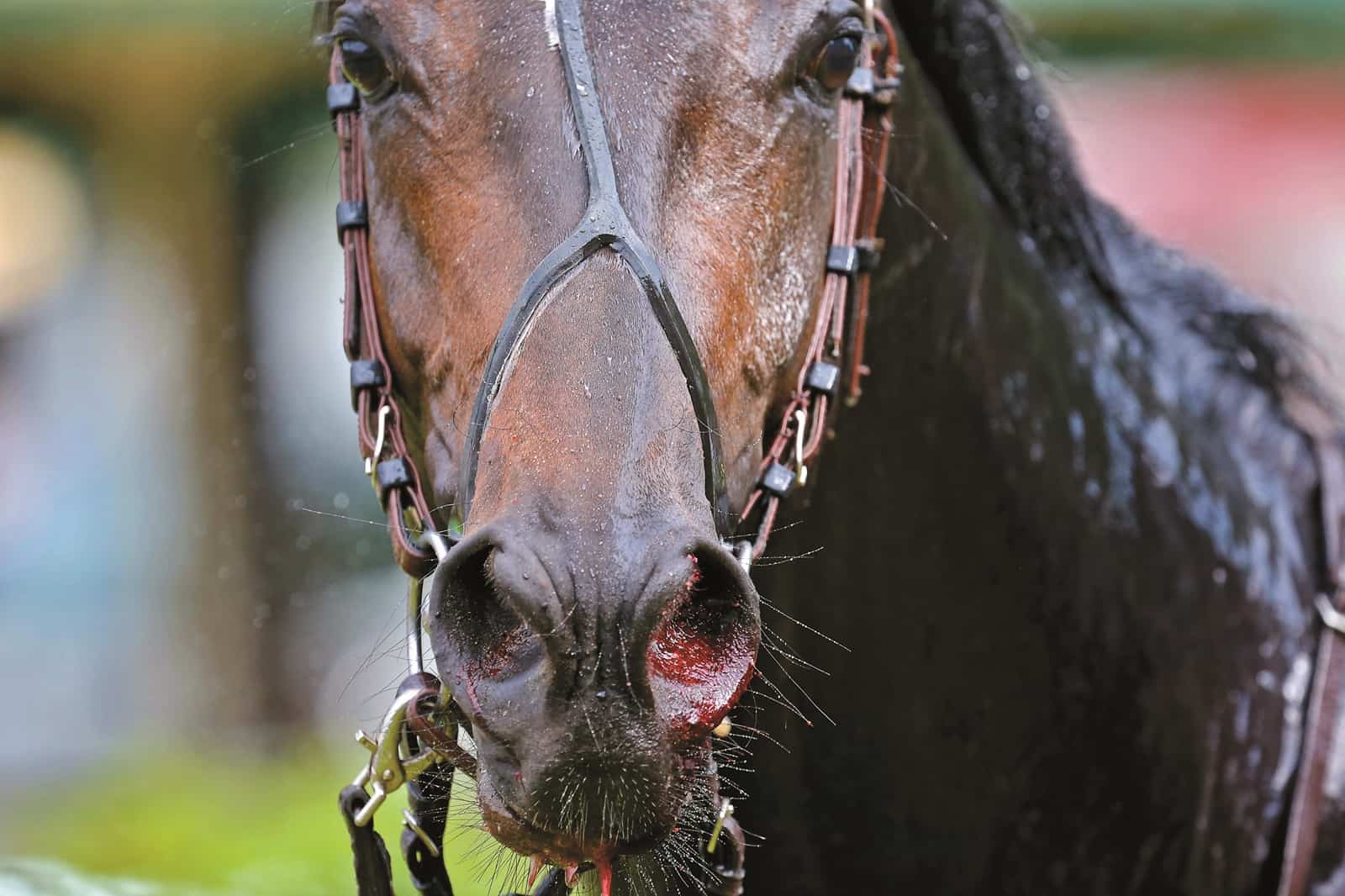EIPH: Why Do Horses Bleed?

Exercise-induced pulmonary hemorrhage (EIPH) is a condition in which horses experience lung bleeding during exercise. It’s a common and concerning phenomenon in horses that veterinarians and researchers are continuing to learn more about. Guy Lester, DVM, PhD, Dipl. ACVIM (LAIM), professor and chair of the University of Florida’s Department of Large Animal Clinical Sciences, explained why horses “bleed” during a presentation at the university’s 2020 Healthy Horses Conference.
The History of Bleeding
Horse people have known since the 1700s, said Lester, that exercise can be associated with blood coming from horses’ nostrils (called epistaxis). Take prominent 18th century Thoroughbred stallion Bartlett’s Childers, for instance. He was dubbed Bleeding Childers because of his propensity to bleed from the nostrils after racing.
“Interestingly, even though this phenomenon of blood coming from the nostrils has been recorded for hundreds of years, it wasn’t until the advent of the flexible endoscope that we realized blood was coming from lungs,” Lester said. “For the longest time we thought it was coming from the upper airway and being inhaled.”
Endoscopy allowed veterinarians to determine that these horses were experiencing lung hemorrhage after exercise. By the 1970s and ’80s, they began to realize how incredibly common the condition was. While we tend to focus on EIPH in Thoroughbred racing, primarily due to concerns over using furosemide (Lasix) as a preventive treatment, it’s widespread across breeds and disciplines, said Lester.
He explained that Standardbreds have a similar EIPH prevalence as Thoroughbreds; polo ponies and barrel racers have a high prevalence; and horses involved in cross-country and show jumping experience it commonly, as well. Even other species, such as racing camels, racing greyhounds, and elite human athletes such as cyclists, are susceptible after periods of maximum exertion.
Why Does it Happen?
To understand why EIPH occurs, you must first understand how the lungs function during breathing and exercise. During respiration, blood moves through the air-filled lungs to take up oxygen and give off carbon dioxide. The lungs must extract as much oxygen from inspired air as possible to transfer to the blood and give up as much carbon dioxide as possible to fulfill the requirements of respiration.
“As a consequence, you need a very thin barrier between the blood vessels and the airways—called the blood gas barrier,” said Lester. “It needs to be thin (about a third of a micron) for gases to exchange, but if it’s too thin it can’t handle high pressure. The suspicion we have is this thin barrier is not quite strong enough.”
When horses exercise, they develop enormous pressure in the blood vessels within their lungs that can lead to stress failure of the pulmonary capillaries (small blood vessels).
“We know that the pressures that are generated during exercise exceed the pressure required to break those membranes and break down the blood gas barrier,” said Lester.
He said researchers believe that rupture is a side effect of selective breeding: “To be a successful athlete, you need to have the thinnest possible blood gas barrier.”
Combine that thin membrane with horses’ enormous cardiac output (the volume of blood that exits the heart), and you have a recipe for failure.
“The oxygen requirement in tissues like muscle during maximum exercise are tremendous,” Lester explained. “Your normal horse heart rate at rest might by 30 beats per minute, but during exercise that might go up to 240 beats per minute.”
In fact, so much blood is being circulated during exercise that the heart has trouble keeping up.
“The blood goes through the lungs at enormous pressure and comes back to the left heart to be ejected out in the circulation,” Lester explained. “Well, that left heart doesn’t really have the ability to handle all the blood coming back effectively. That puts further pressure on the lungs, and it goes up higher and higher. Ultimately, when a horse exercises, we have an increase in pulmonary vascular pressure (blood pressure in the lungs). It can go from 20 milliliters of mercury to, say, 100 milliliters of mercury, far exceeding the breaking strain of those little blood vessels in the lungs.”
At the same time, the pressure inside the horse’s airway during exercise drops. So pressure on the airway side of the blood gas barrier decreases, pressure on the blood side increases, and the result is capillary transmural pressure that rises to the point of failure. When the barrier fails, the pulmonary capillaries rupture, blood moves into and pools in the airways, then moves down into the trachea. If the bleeding is excessive, it can reach the nostril.
Complications
The sequence of steps just described are normal physiological events, said Lester, not a disease process. Other factors, however, can complicate EIPH.
If a horse bleeds repeatedly, for instance, over time the pulmonary veins feeding the vessels in the lungs will become stiff and develop fibrosis (scarring)—a condition called veno-occlusive remodeling.
“The normal vein that needs to expand in response to increased blood flow into the lungs becomes restricted,” said Lester. “With age and repeated episodes of EIPH, the pulmonary veins might become stiffer and will increase pressure in lung.”
Horses with concurrent airway problems such as dorsal displacement of the soft palate, cysts, entrapments, and laryngeal hemiplegia can experience heightened negative pressure in their lungs, he said. Plus, as a progressive condition, EIPH typically worsens over time.
“The good news is at the early stages of EIPH we know the damage is reversible,” said Lester. “So once the pressure falls, you have healing of that break in the blood gas barrier.”
Take-Home Message
EIPH is a common and progressive condition that likely occurs as a consequence of our evolutionary strategy to breed the fastest horses, Lester said in closing.
“Remember though, EIPH is not restricted to horses or Thoroughbreds,” he said. “It occurs across range of disciplines and multitude of species. The principles that contribute to this are probably shared, and having that knowledge will help us understand the benefits of using Lasix.”

Written by:
Alexandra Beckstett
Related Articles
Stay on top of the most recent Horse Health news with















